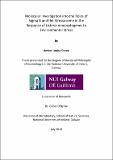| dc.description.abstract | The alternative sigma factor, SigB, has been studied extensively in Listeria monocytogenes, Bacillus subtilis and Staphylococcus aureus, and is known to regulate the general stress response in these bacteria. The activation of SigB by a stress occurs via a signalling cascade, upstream of which is the stressosome complex. The stressosome is a large protein complex composed of RsbS, RsbT and RsbR proteins, with the RsbR proteins hypothesised to function as stress sensors. RsbR has four paralogues, Lmo0161, Lm0799, Lmo1642 and Lmo1842, of which only Lmo0799 has been established to act as a stress sensor. Lmo0799 is a blue light sensor, but somewhat surprisingly inactivation of the corresponding gene does not result in sensitivity to blue light.
In the current study, environmental factors including growth phase and temperature, along with exposure to ethanol or alternative carbon sources, were identified to alter the sensitivity of L. monocytogenes to killing by blue light. Whole transcriptomic analysis of the wild-type, SigB deletion mutant and a mutant for which the conserved cysteine residue critical for blue light sensing in Lmo0799, C56, has been changed to an alanine, designated lmo0799 C56A, in the presence of blue light identified a key role for SigB in altering gene transcription in response to blue light exposure. In addition, it confirmed the ability of the C56A mutant to upregulate genes under the control of SigB in response to blue light exposure, although to a lesser extent than the wild-type. These data provide further evidence that L.
monocytogenes is able to sense and respond to secondary stresses associated with blue light exposure, such as ROS. Finally, the reconstruction of Dlmo1642 and Dlmo1842 deletion mutants enabled the confirmation that there is a redundancy between the stress sensing abilities of these proteins and the other RsbR paralogues that has previously been associated with Lmo0161. | en_IE |


